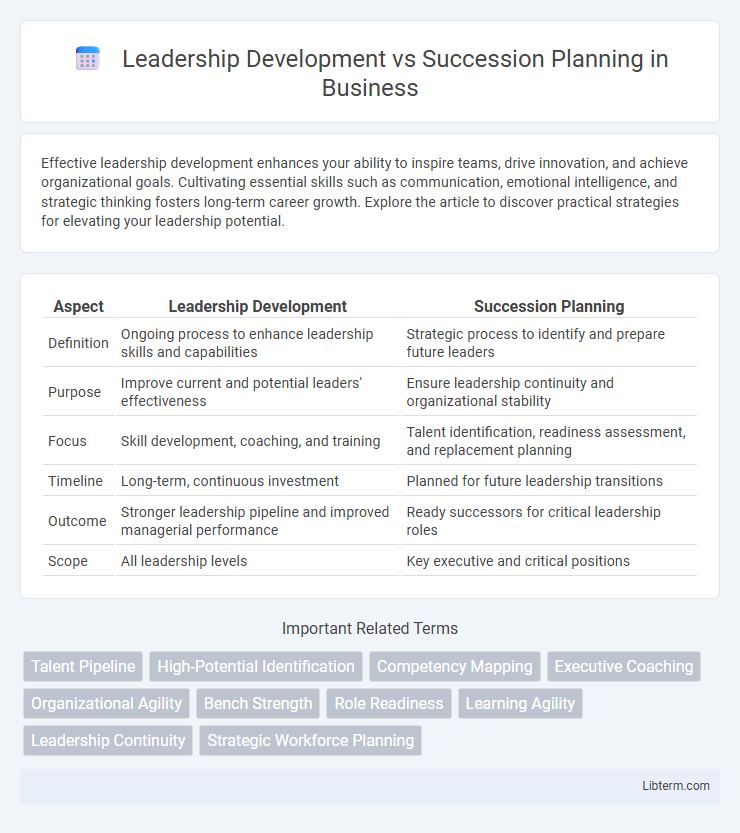Effective leadership development enhances your ability to inspire teams, drive innovation, and achieve organizational goals. Cultivating essential skills such as communication, emotional intelligence, and strategic thinking fosters long-term career growth. Explore the article to discover practical strategies for elevating your leadership potential.
Table of Comparison
| Aspect | Leadership Development | Succession Planning |
|---|---|---|
| Definition | Ongoing process to enhance leadership skills and capabilities | Strategic process to identify and prepare future leaders |
| Purpose | Improve current and potential leaders' effectiveness | Ensure leadership continuity and organizational stability |
| Focus | Skill development, coaching, and training | Talent identification, readiness assessment, and replacement planning |
| Timeline | Long-term, continuous investment | Planned for future leadership transitions |
| Outcome | Stronger leadership pipeline and improved managerial performance | Ready successors for critical leadership roles |
| Scope | All leadership levels | Key executive and critical positions |
Introduction to Leadership Development and Succession Planning
Leadership development cultivates essential skills, behaviors, and mindsets for current and future leaders, emphasizing continuous learning, coaching, and experiential growth. Succession planning strategically identifies and prepares high-potential talent to fill key leadership roles, ensuring organizational stability and long-term success. Both processes integrate workforce analytics, competency mapping, and talent pipelines to align leadership capabilities with business objectives.
Defining Leadership Development
Leadership development encompasses targeted strategies and programs aimed at enhancing individuals' skills, behaviors, and competencies to become effective leaders within an organization. This process focuses on continuous learning, self-awareness, and practical experience to cultivate leadership abilities aligned with organizational goals. Leadership development drives employee engagement and prepares leaders to manage complex challenges, distinguishing it from succession planning's emphasis on identifying and preparing specific individuals for future leadership roles.
Understanding Succession Planning
Succession planning is a strategic process focused on identifying and preparing high-potential employees to fill key leadership roles, ensuring organizational continuity and minimizing disruptions during transitions. It involves assessing talent gaps, creating development plans, and aligning individual growth with future business needs. Effective succession planning enhances leadership pipelines, reduces turnover risks, and supports long-term organizational stability.
Key Differences Between Leadership Development and Succession Planning
Leadership development focuses on enhancing the skills, competencies, and performance of current and potential leaders through training and mentoring programs. Succession planning identifies critical roles within an organization and prepares specific individuals to fill those positions when vacancies arise, ensuring business continuity. While leadership development emphasizes individual growth, succession planning aligns talent readiness with strategic organizational needs and future leadership gaps.
Benefits of Leadership Development for Organizations
Leadership development enhances organizational performance by cultivating skilled leaders capable of driving innovation and managing change effectively. It promotes employee engagement and retention through continuous professional growth opportunities, leading to a more motivated and productive workforce. Investing in leadership development also ensures a strong leadership pipeline, reducing risks associated with leadership gaps and supporting long-term business sustainability.
Strategic Value of Succession Planning
Succession planning holds strategic value by ensuring organizational continuity and minimizing disruption during leadership transitions. It systematically identifies and prepares high-potential talent to fill critical roles, aligning workforce capabilities with long-term business goals. Effective succession planning supports risk management and strengthens competitive advantage through proactive leadership pipeline development.
Integrating Leadership Development with Succession Planning
Integrating leadership development with succession planning ensures a seamless pipeline of skilled leaders ready to step into critical roles, enhancing organizational stability and performance. By aligning targeted leadership training programs with identified succession needs, companies can proactively prepare high-potential employees for future challenges and responsibilities. This strategic approach fosters continuous talent growth, minimizes leadership gaps, and supports long-term business success.
Common Challenges in Implementation
Leadership development and succession planning often face common implementation challenges such as unclear organizational goals, lack of stakeholder buy-in, and insufficient resources for training programs. These barriers hinder the identification and preparation of high-potential employees, resulting in gaps in leadership continuity and effectiveness. Overcoming these challenges requires aligning development initiatives with strategic objectives and fostering a culture of continuous leadership growth.
Measuring Success: Metrics and Outcomes
Measuring success in Leadership Development involves tracking improvements in leadership competencies, employee engagement scores, and the achievement of strategic goals. Succession Planning metrics focus on the readiness of internal candidates, time-to-fill leadership vacancies, and retention rates of high-potential employees. Both approaches benefit from data-driven evaluations to align leadership capabilities with long-term organizational performance.
Future Trends in Leadership and Succession Strategies
Leadership development increasingly integrates artificial intelligence and data analytics to personalize growth paths and predict leadership potential within organizations. Succession planning evolves with a focus on agile, cross-functional talent pools that adapt to rapid market changes and emerging business models. Future strategies emphasize continuous learning ecosystems and diversity-driven leadership pipelines to foster innovation and resilience.
Leadership Development Infographic

 libterm.com
libterm.com